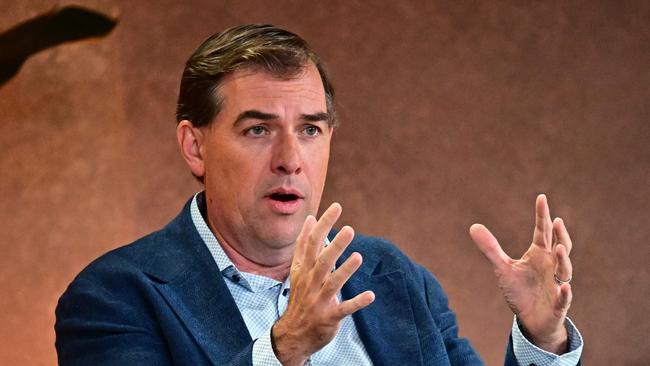Nuclear power is a valuable part of solving global energy shortages says Amazon Matt Garman
Amazon Web Services boss Matt Garman predicts every country in developed world will turn to nuclear power in coming decades as energy needs grow and net zero carbon emissions targets loom.

Nuclear power is a “super valuable” part of solving global energy shortages according to the head of Amazon’s tech business Matt Garman, who predicts “every country” will leverage it at some point.
His comments come as opposition leader Peter Dutton has declared Australia must consider nuclear options to tackle the expected power shortage that will come from the nation shutting down its ageing coal fired plants in order to reach net zero carbon emission targets.
Amazon Web Services (AWS) announced last month it will invest more than US$500m in nuclear energy in the US to pre-emptively tackle a likely energy shortage stemming from the massive expansion into generative AI, and as part of its own net-zero policy.
“I think it is an important part of solving the world’s energy needs over coming decades and I think over time every country will likely start to leverage nuclear in some way,” AWS chief executive Matt Garman said when asked by The Australian about countries that have ruled nuclear power out. “I think it’s a super valuable component to the future energy solve and it’s incredibly safe, it’s very cost effective at scale.”
In June Mr Dutton came out with a long-awaited energy policy differentiator from the Albanese government - which is firmly against nuclear - by announcing it would build seven sites for reactors, many to be located at former or current coal power plants, declaring the first could be open in the next decade.
There are two federal laws that currently prevent nuclear power, the Environment Protection and Biodiversity Conservation Act 1999, and the Australian Radiation Protection and Nuclear Safety Act 1998, as well as Individual state legislation.
Nuclear power produces only a third of the carbon emissions that come from solar power and a similar amount of carbon emissions as wind power, according to the World Nuclear Association.
However, the reputation of nuclear was badly damaged by the disasters at Chernobyl and Three Mile Island, and more recently Fukushima.
If elected, Dutton’s plan involves a mix of large reactors and two small-modular reactors, a technology still in development in the western world. Russia and China are the only two countries to have successfully built reactors using this technology, which proponents say will be safer than large reactors and cheaper to build.
The US is the world’s biggest producer of nuclear power but there have been almost no new plants built in 30 years because of fears over the prospect of meltdowns, the high capital outlay, and declining cost of rival energy sources such as gas.
The CSIRO estimates a 1,000MW nuclear plant built today would cost at least $8.6bn.
But clearly unofficial messaging on nuclear power has changed in Washington, leading to massive nuclear power announcements by Amazon, Google, and Microsoft.
Garman says that he envisages AWS using a combination of large nuclear power and small modular technology.
The current AWS nuclear investments are in the US and the company says it will only pursue nuclear energy power sources in countries where it is a “viable option.”
“These small modular reactors are early, so there’s some technology advancement that needs to happen,” says Garman.
“But I think even large nuclear plants are an important part of solving the world’s energy needs over the coming decades. And I think, over time, every country will likely start to leverage nuclear power in some way, shape or form.”
The reason Big Tech is suddenly leaning hard into nuclear power is because they see they will need it to survive long term.
Hyper scalers (big cloud providers) are likely to consume 8 per cent of America’s power output by 2030, up from 2 per cent in 2022, according to estimates by Goldman Sachs. That’s in large part due to the massive amounts of energy required to run tasks using generative AI models.
“If you go back two decades, when we needed more power we would just ask the utility and they would give us more because it was relatively small,” says Garman. “Those days are mostly passed. And so now we need to think more about energy as part of our supply chain… and how we make sure that there’s enough capacity.”
Amazon and Google are investing in the development of new nuclear plants and Microsoft has taken the more radical step of announcing it will resurrect part of Pennsylvania’s Three Mile Island facility, the site of America’s worst nuclear meltdown 45-years ago.
Garman says AWS is focused on being able to meet its energy requirements and its zero carbon pledge.
“We think about do we have enough power in 2024, how do we have enough power for 25 how do we have enough power for 2030 how do we have enough power for 2040,” Garman says before joking AWS, “hasn’t solved 2040 yet fully, but we do think that that far out.”
It might be back to the drawing board for some of his plans. Late on Friday (after this interview was conducted) US energy regulators rejected a plan for AWS to connect a data centre directly to the Talen Energy nuclear power plant in Pennsylvania.
Earlier this year AWS signed a deal to purchase nuclear power from the company’s existing Susquehanna Steam Electric Station and also agreed to pay US$650m for an adjacent, nuclear-powered data centre campus.
Last month, AWS also announced a deal with Dominion Energy, Virginia’s utility company, to try develop a small nuclear reactor near its existing North Anna nuclear power station.
Amazon is the world’s top corporate buyer of solar and wind energy. Garman says it’s not just about buying existing projects.
“We’ve commissioned more than 500 renewable projects over the last five years and we’ll continue to do that as we add more and more of these new green energy sources to the grid,” Garman says. “And as we look at that ramp, it’s clear that things like wind and solar aren't going to be enough. And so we’ve started leaning into nuclear.”
Amazon is the only one of the Big Tech three that has met its own carbon targets this past year.
The International Energy Agency has predicted data centre electricity consumption could reach more than 1,000 terawatt hours in 2026. That’s double the figure from 2022. By comparison, one terawatt hour can power 70,000 homes for a year.
The writer travelled to Seattle as a guest of AWS.




To join the conversation, please log in. Don't have an account? Register
Join the conversation, you are commenting as Logout